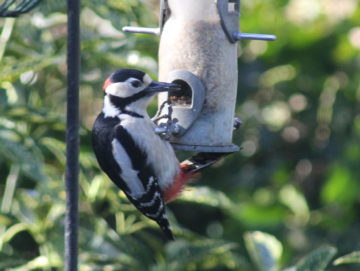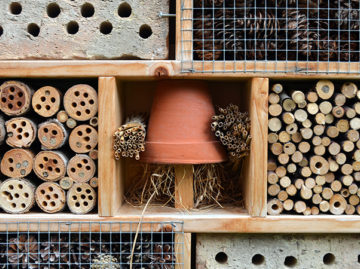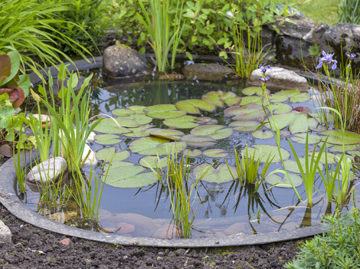This website uses cookies so that we can provide you with the best user experience possible. Cookie information is stored in your browser and performs functions such as recognising you when you return to our website and helping our team to understand which sections of the website you find most interesting and useful.
Making your garden wildlife-friendly
In this section we provide an outline of some of the things involved in making a garden wildlife friendly. If all this looks rather overwhelming, just remember that you certainly don’t have to do everything. Doing just one or two things from the list will be a great help for wildlife. It is worth emphasising that a wildlife-friendly garden isn’t the same as a neglected, messy garden. Indeed a neglected and overgrown garden is likely to be less wildlife-friendly than one that is managed, with the right plants, feeders and niches in place.

You don’t have to attempt making the whole of your garden wildlife-friendly. You can make most of your garden fit your needs and your likes, whilst leaving just a small section for the needs and likes of wildlife. Try ‘framing’ your wildlife section (with a brick path or a mowed strip of lawn) and make a feature of it.
Books and online advice
You will find a lot of on-line advice about how to make your garden wildlife friendly. One of the best guides is provided by the Royal Society for the Protection of Birds. Step-by-step guides are also given by the Natural History Museum and National Trust. There are also plenty of books and booklets providing useful information. An especially good book is Wildlife Gardening: For Everyone and Everything, by Kate Bradbury. Another is Gardening for Wildlife which is an RSPB book, written by Adrian Thomas. Both of these books can be bought from lots of sources, including the Suffolk Wildlife Trust online shop and the RSPB online shop. If you want a good read, try Dave Goulson ‘The Jungle Garden’.

In the nine sections below, and in the paragraph above, you will find lot of clickable links – in bold type. They will take you to websites where more detailed and authoritative advice is given.

Choosing wildlife-friendly flowers and plants
Some flowers and plants are more wildlife-friendly than others. For example, many modern hybrid flowers with multiple layers of petals or blooms look very pretty, but often have far less nectar and pollen, and are less beneficial to potential feeding insects.
A quick and easy test of which flowers are insect-friendly, is to visit an outdoor garden centre in spring or summer and see which plants are attracting the bees and butterflies. If you’re tempted to buy, buy those!
A word of caution: some pristine plants labelled as ‘bee-friendly’ might have been grown in greenhouses using pesticides, and those toxins can be dangerous for all insects. A local ‘plant sale’, would be a much safer bet. Or, even better (and cheaper), grow your own plants from seed.
There is a lot of advice about choosing and planting wildlife-friendly flowers and shrubs. Here are some useful websites:

Helping feed wildlife
Whilst wildlife friendly flowers and insects help provide food for insects, birds might need an extra helping hand with finding food sources, especially in the winter. The sale of bird food – seeds, nuts, suet, mealworms, etc – is a thriving industry nowadays and you shouldn’t have any problem with finding a source. If you require one recommendation, you could try Vine House Farm who donate a proportion of their profits to the Wildlife Trusts. The Wildlife Trusts have a good guide on to how to feed birds in your garden.
Remember that placing your feeder in a good spot – usually near a bush or hedge – is also important. You should ensure that bird feeders are cleaned occasional to prevent the spread of avian diseases. Birds will also need places to drink and bathe. A bird bath in your garden can be an ornamental feature and it can provide a life-line to birds. The RSPB provides advice on providing water for birds. You can go as big and expensive, or a cheap and cheerful as you like with a bird bath. Some other creatures may also benefit from feeding. This is especially so for Hedgehogs (see later section).

Erecting nest boxes
Again, there are plenty of online stores
for nest boxes or you may see them for sale at garden centres or nature reserves. It is, of course, perfectly possible to make a bird nest box yourself. Again, the RSPB provides a simple guide to building and placing a nest box. It is important to clean out your nest box after the breeding season, to prevent mites and disease. Leave them up over the winter: Blue Tits often roost together in nest boxes in the coldest of weather. You could also think about erecting a bat box. Again, these can be purchased or made. The Wildlife Trusts provide a set of simple instructions for making a bat box. You will need to place bat boxes in an appropriate location, and The Bat Conservation Trust offers advice.

Building a bug hotel
Insects and other mini-beasts need safe spaces to shelter, hide from predators and raise their young. You can help them by building a ‘bug hotel’ in your garden or outside area. You can purchase these (and some of them look very attractive), but a ‘bug hotel’ is just the sort of thing you can have fun assembling yourself. Good advice on ‘bug hotels’ is provided by The Woodland Trust.
If you are trying to provide a home for solitary bees, don’t make the bee hotel too large as putting too many solitary bees together in a small space attracts potential parasites.

Spaces where wildlife can shelter and thrive
If you have a corner of your garden -perhaps behind a shed, or tucked away behind bushes – you could leave it undisturbed, perhaps after piling up a few logs there. These unseen, neglected spaces can be a shelter for all sorts of wildlife. Come the end of summer, it can be beneficial not to cut back on all the plants in your garden. Seed heads of plants that have finished flowering can provide food for finches. Ivy is an autumnal magnet for polinators. If you have Ivy growing in your garden, don’t cut it back too early.
The more your garden is ‘3D’, with hedges and trees, the more niches and food sources it will provide for wildlife.

What to do with the lawn?
If you have an established lawn, there are many ways in which you can manage and shape it into a better home for nature. Mowing your lawn a little less, saves you time and provides another home and aid for wildlife. The RSPB provides more information about lawns and nature. They recommend: raising the blades on your lawn mower to increase the minimum height of your grass to around 4cm, and cut it less frequently to benefit both the wildlife and the grass. Of course, you could leave the grass longer in some sections and shorter in others – it all depends on the size and layout of your garden. In moist, warm summer weather, you may need to cut your grass more often (weekly), but in dry weather, you could cut less frequently to help reduce drought stress and keep it green for longer. Having said all this, be warned that simply letting all your grass grow very long, will not necessarily be the best way to help nature and, if nettles take over, it won’t be an appealing place to look at or sit in.

Making your garden hedgehog friendly
Hedgehogs are suffering a concerning decline. In rural areas, such as ours, over 50% have been lost in the past two decades. There are things you can do to make your garden hedgehog-friendly, including feeding and helping to make ‘hedgehog highways’ between gardens. The Suffolk Wildlife Trust provides excellent advice and the British Hedgehog Preservation Society has a great leaflet.

A small garden pond
A source of water in your garden will be highly attractive for all sorts of wildlife. You will find a range of different and interesting types of insect frequenting your garden: Pond-skaters and Water Boatman will be the most obvious. Stunning dragonflies and damselflies will come to lay their eggs and, much later, the larvae will develop into adults. A whole cycle of life will be happening in your back garden. Advice on how to build a wildlife garden pond is provided by The Wildlife Trusts.
A water source in your garden needn’t be a large, laborious and expensive venture. There are lots of ideas about how to make smaller ponds. Once again, The Wildlife Trusts have ideas for you. Make sure that you have some vegetation in your pond, including some oxygenating plants. The Freshwater Habitats Trust has lots of
detailed advice.

Pesticides and weedkillers
Some pesticides and weedkillers contain chemicals that can harm wildlife and the environment. It is perfectly possible to have a healthy, flourishing garden when using pesticides and weedkillers only as a last resort. There are alternatives to pesticides. ‘Companion planting’ can deter pests. For example, planting marigolds near vegetables can help keep Greenfly and Blackfly away Predators such as ladybirds eat pests, so they’re great to have in the garden. Responsible use of pesticides can minimise the harm they can do to certain useful insects. It is often more effective and safe just to pull up weeds, rather than reaching for the weedkiller. The Royal Horticultural Society has some hints on controlling pests and diseases in the garden without using chemicals.
Metaldehyde-based slug pellets pose a risk to bird and mammals, and a ban on these pellets comes into force from 31st March 2022. If you have a stock of these pellets, please don’t use them; dispose of them appropriately.

